F-MAT 120: Exploring Mathematics Teaching in Foundation Phase
VerifiedAdded on 2023/06/12
|10
|2152
|112
Homework Assignment
AI Summary
This assignment solution for F-MAT 120, Introduction to Mathematics Teaching in the Foundation Phase, covers key concepts relevant to teaching mathematics in the foundation phase. The assignment includes tasks on matching phrases to concepts related to number sense, understanding Piaget's stages of development, and addressing challenges in number conservation. It provides concrete activities and scenarios for teaching number conservation, along with questions to assess understanding. Furthermore, the solution delves into the importance of number sense, pre-number concepts like classification, and knowledge in counting. It also explains mathematical techniques such as skip counting, ordering, estimation, and number recognition using South African coins as examples. The assignment concludes with an analysis of learners' ability to identify number symbols and suggests practical activities to improve their understanding. Desklib provides this assignment and many others, offering students a comprehensive resource for their studies.
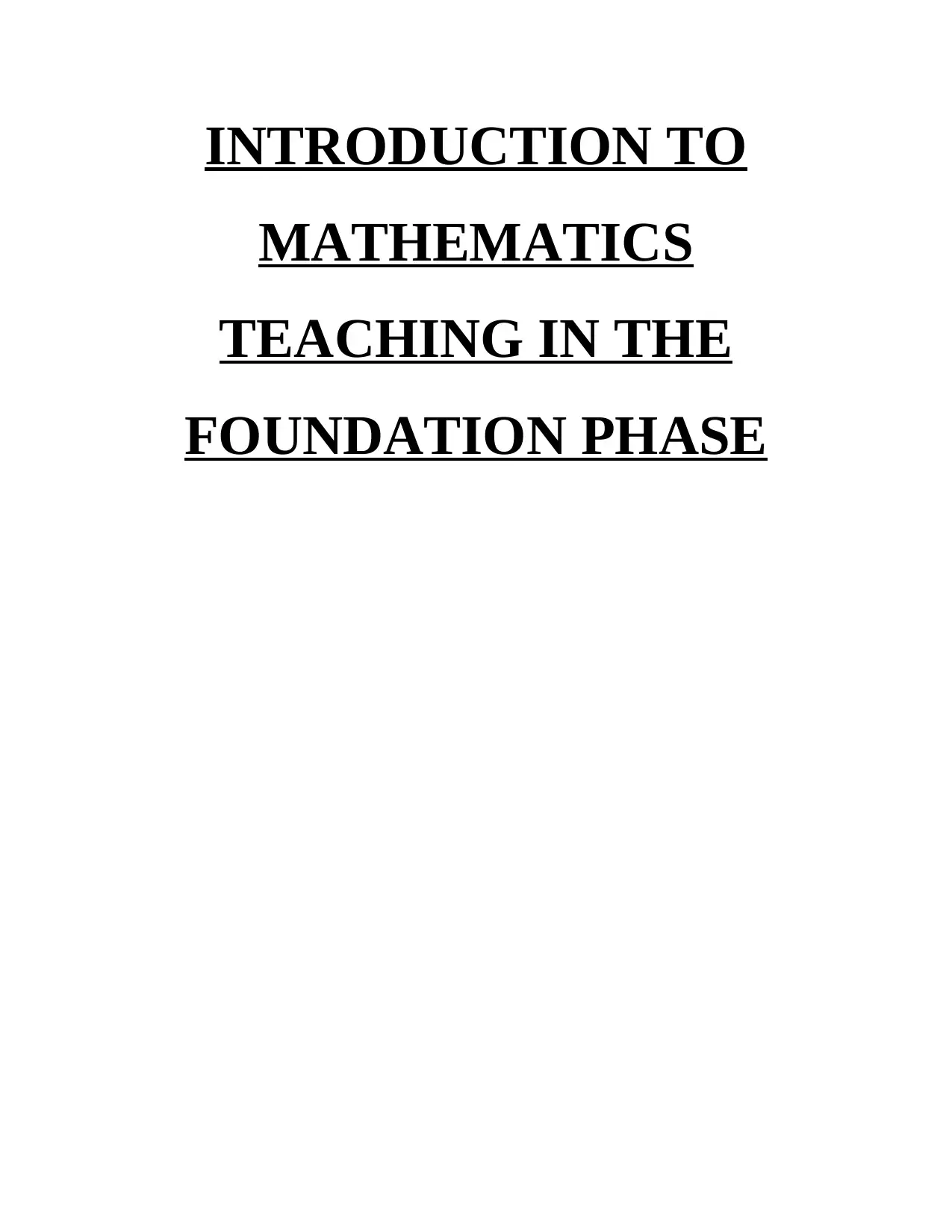
INTRODUCTION TO
MATHEMATICS
TEACHING IN THE
FOUNDATION PHASE
MATHEMATICS
TEACHING IN THE
FOUNDATION PHASE
Paraphrase This Document
Need a fresh take? Get an instant paraphrase of this document with our AI Paraphraser
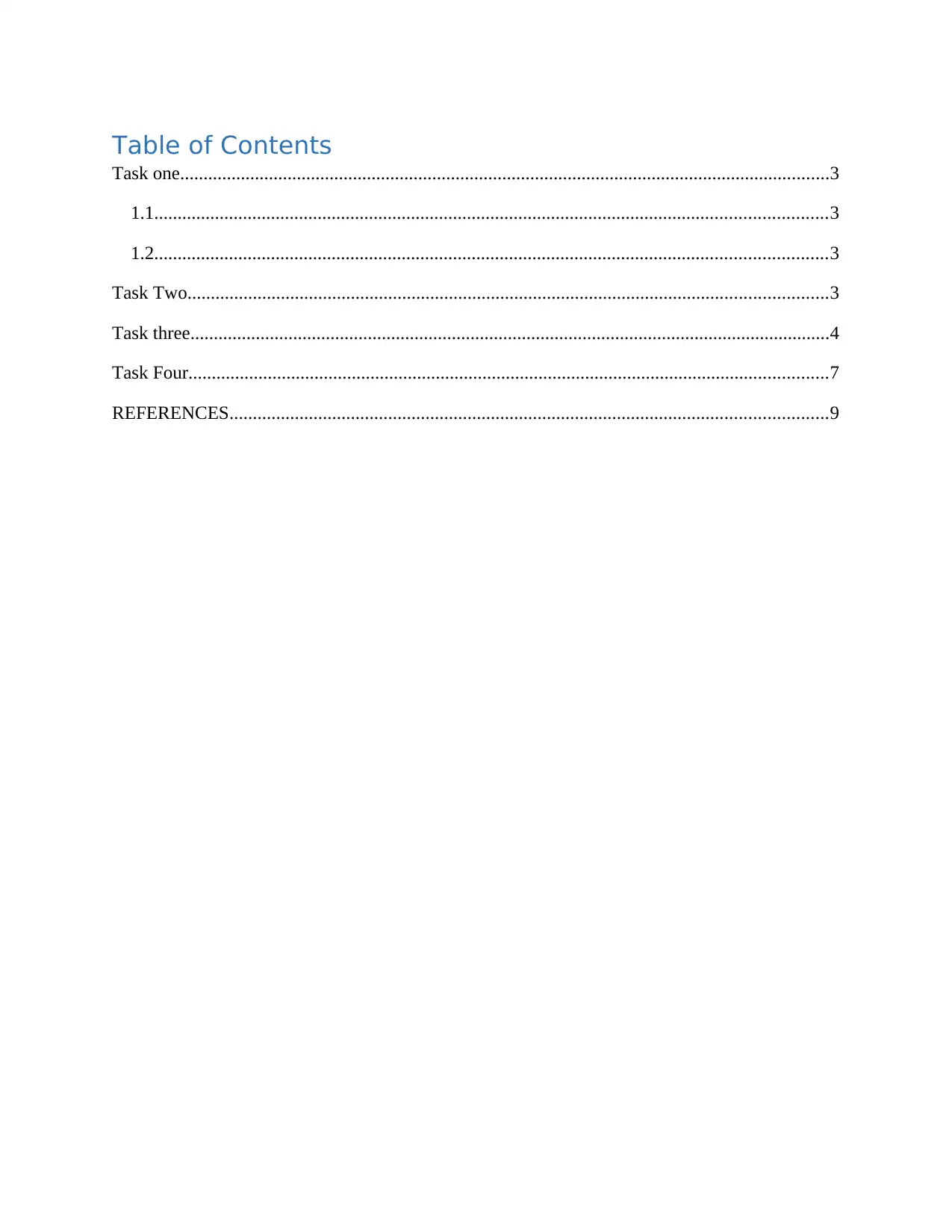
Table of Contents
Task one...........................................................................................................................................3
1.1................................................................................................................................................3
1.2................................................................................................................................................3
Task Two.........................................................................................................................................3
Task three.........................................................................................................................................4
Task Four.........................................................................................................................................7
REFERENCES................................................................................................................................9
Task one...........................................................................................................................................3
1.1................................................................................................................................................3
1.2................................................................................................................................................3
Task Two.........................................................................................................................................3
Task three.........................................................................................................................................4
Task Four.........................................................................................................................................7
REFERENCES................................................................................................................................9
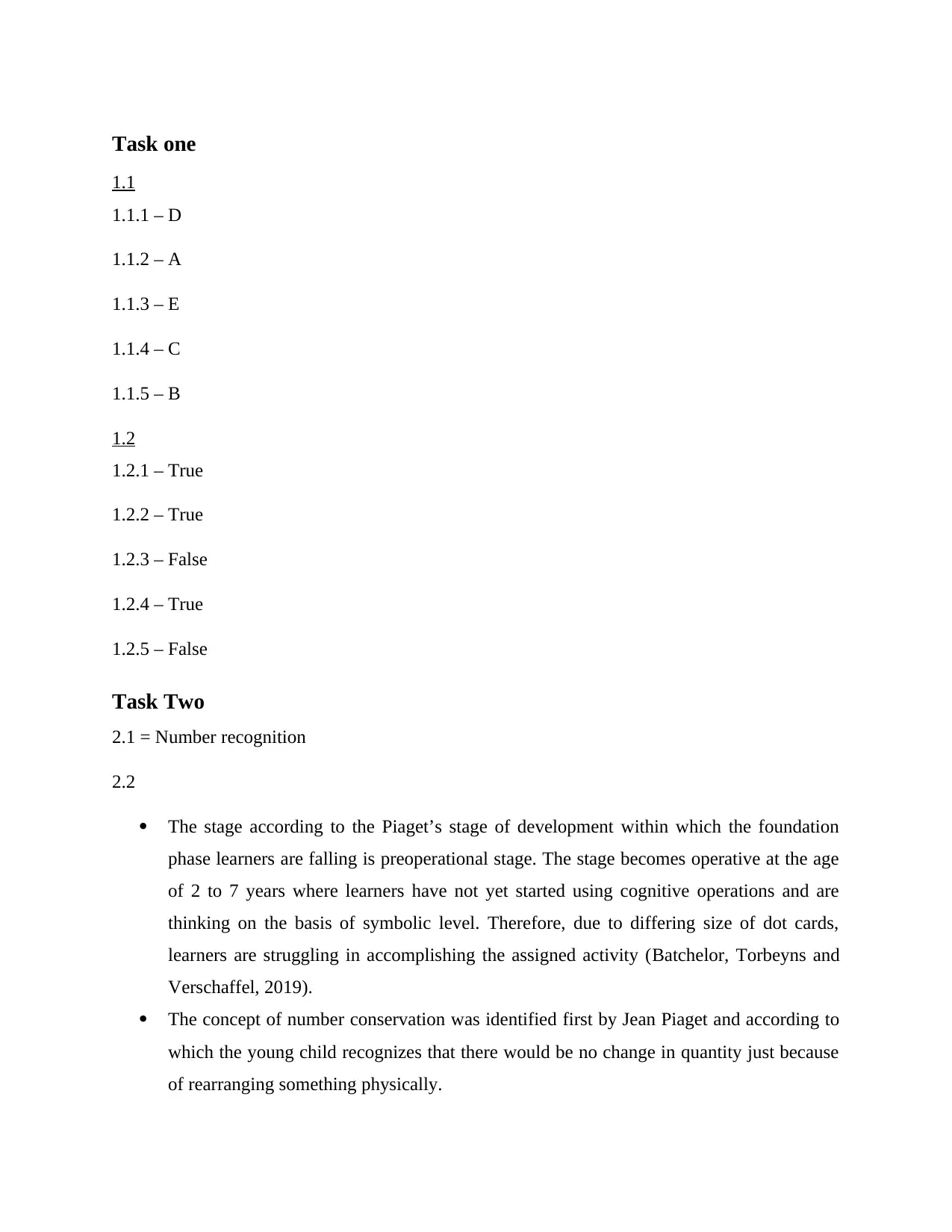
Task one
1.1
1.1.1 – D
1.1.2 – A
1.1.3 – E
1.1.4 – C
1.1.5 – B
1.2
1.2.1 – True
1.2.2 – True
1.2.3 – False
1.2.4 – True
1.2.5 – False
Task Two
2.1 = Number recognition
2.2
The stage according to the Piaget’s stage of development within which the foundation
phase learners are falling is preoperational stage. The stage becomes operative at the age
of 2 to 7 years where learners have not yet started using cognitive operations and are
thinking on the basis of symbolic level. Therefore, due to differing size of dot cards,
learners are struggling in accomplishing the assigned activity (Batchelor, Torbeyns and
Verschaffel, 2019).
The concept of number conservation was identified first by Jean Piaget and according to
which the young child recognizes that there would be no change in quantity just because
of rearranging something physically.
1.1
1.1.1 – D
1.1.2 – A
1.1.3 – E
1.1.4 – C
1.1.5 – B
1.2
1.2.1 – True
1.2.2 – True
1.2.3 – False
1.2.4 – True
1.2.5 – False
Task Two
2.1 = Number recognition
2.2
The stage according to the Piaget’s stage of development within which the foundation
phase learners are falling is preoperational stage. The stage becomes operative at the age
of 2 to 7 years where learners have not yet started using cognitive operations and are
thinking on the basis of symbolic level. Therefore, due to differing size of dot cards,
learners are struggling in accomplishing the assigned activity (Batchelor, Torbeyns and
Verschaffel, 2019).
The concept of number conservation was identified first by Jean Piaget and according to
which the young child recognizes that there would be no change in quantity just because
of rearranging something physically.
⊘ This is a preview!⊘
Do you want full access?
Subscribe today to unlock all pages.

Trusted by 1+ million students worldwide
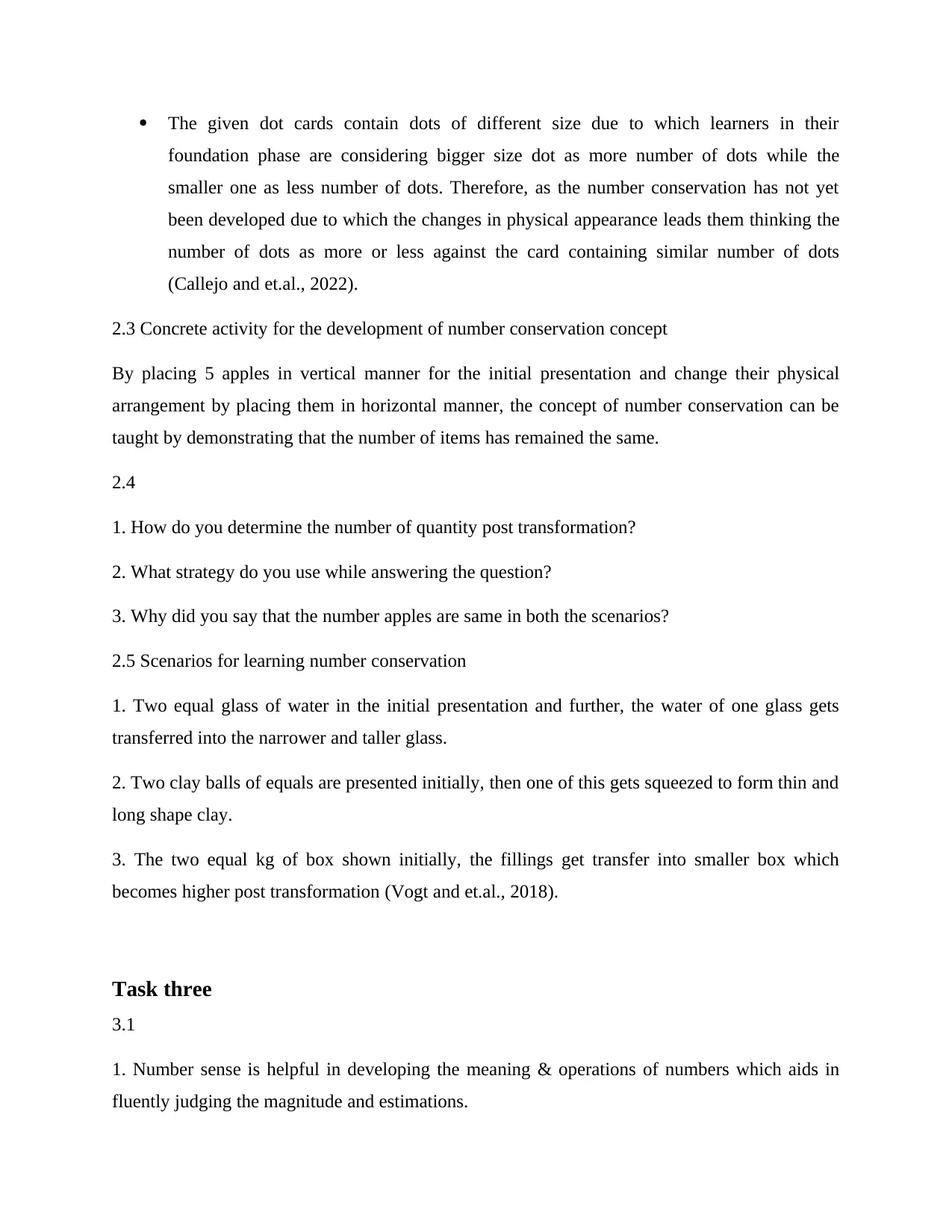
The given dot cards contain dots of different size due to which learners in their
foundation phase are considering bigger size dot as more number of dots while the
smaller one as less number of dots. Therefore, as the number conservation has not yet
been developed due to which the changes in physical appearance leads them thinking the
number of dots as more or less against the card containing similar number of dots
(Callejo and et.al., 2022).
2.3 Concrete activity for the development of number conservation concept
By placing 5 apples in vertical manner for the initial presentation and change their physical
arrangement by placing them in horizontal manner, the concept of number conservation can be
taught by demonstrating that the number of items has remained the same.
2.4
1. How do you determine the number of quantity post transformation?
2. What strategy do you use while answering the question?
3. Why did you say that the number apples are same in both the scenarios?
2.5 Scenarios for learning number conservation
1. Two equal glass of water in the initial presentation and further, the water of one glass gets
transferred into the narrower and taller glass.
2. Two clay balls of equals are presented initially, then one of this gets squeezed to form thin and
long shape clay.
3. The two equal kg of box shown initially, the fillings get transfer into smaller box which
becomes higher post transformation (Vogt and et.al., 2018).
Task three
3.1
1. Number sense is helpful in developing the meaning & operations of numbers which aids in
fluently judging the magnitude and estimations.
foundation phase are considering bigger size dot as more number of dots while the
smaller one as less number of dots. Therefore, as the number conservation has not yet
been developed due to which the changes in physical appearance leads them thinking the
number of dots as more or less against the card containing similar number of dots
(Callejo and et.al., 2022).
2.3 Concrete activity for the development of number conservation concept
By placing 5 apples in vertical manner for the initial presentation and change their physical
arrangement by placing them in horizontal manner, the concept of number conservation can be
taught by demonstrating that the number of items has remained the same.
2.4
1. How do you determine the number of quantity post transformation?
2. What strategy do you use while answering the question?
3. Why did you say that the number apples are same in both the scenarios?
2.5 Scenarios for learning number conservation
1. Two equal glass of water in the initial presentation and further, the water of one glass gets
transferred into the narrower and taller glass.
2. Two clay balls of equals are presented initially, then one of this gets squeezed to form thin and
long shape clay.
3. The two equal kg of box shown initially, the fillings get transfer into smaller box which
becomes higher post transformation (Vogt and et.al., 2018).
Task three
3.1
1. Number sense is helpful in developing the meaning & operations of numbers which aids in
fluently judging the magnitude and estimations.
Paraphrase This Document
Need a fresh take? Get an instant paraphrase of this document with our AI Paraphraser
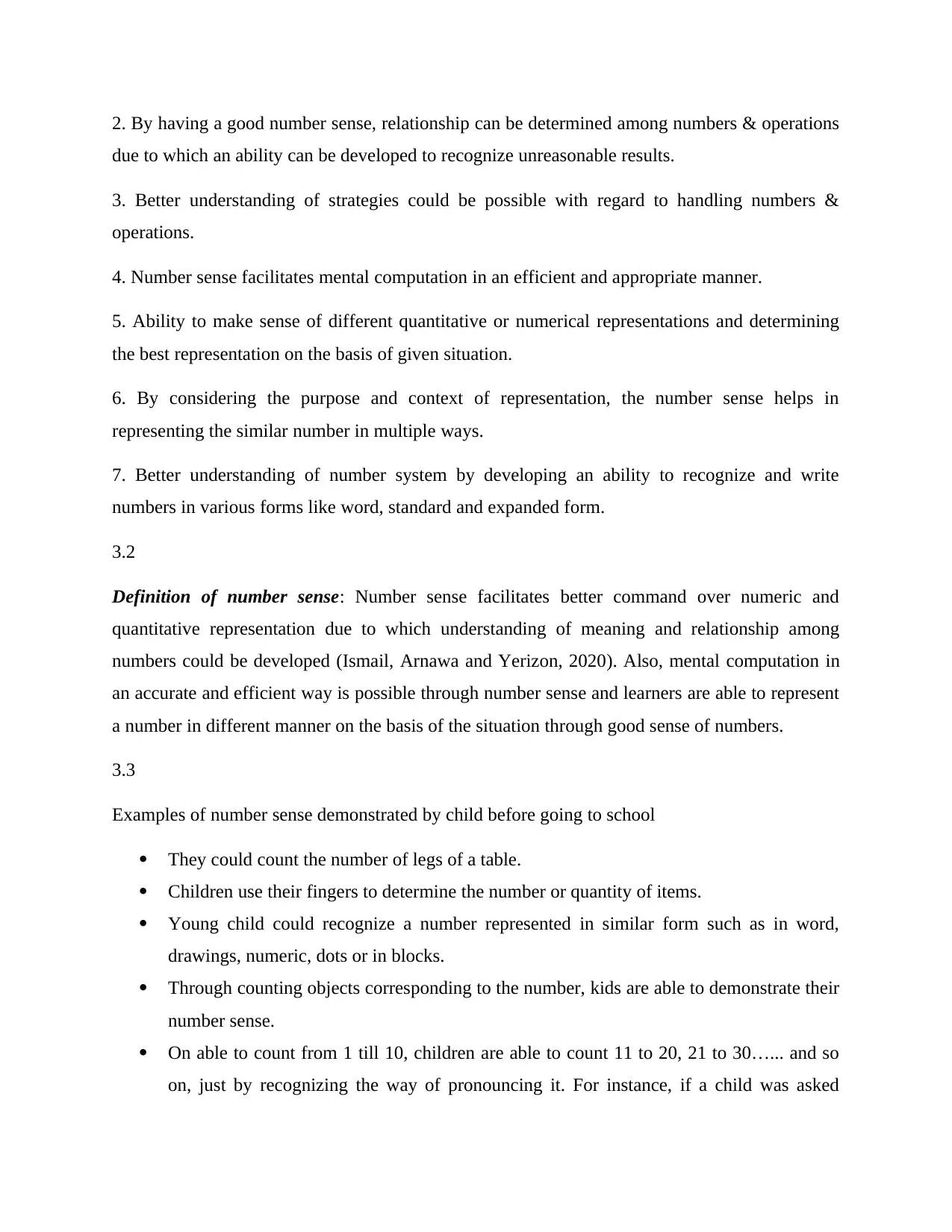
2. By having a good number sense, relationship can be determined among numbers & operations
due to which an ability can be developed to recognize unreasonable results.
3. Better understanding of strategies could be possible with regard to handling numbers &
operations.
4. Number sense facilitates mental computation in an efficient and appropriate manner.
5. Ability to make sense of different quantitative or numerical representations and determining
the best representation on the basis of given situation.
6. By considering the purpose and context of representation, the number sense helps in
representing the similar number in multiple ways.
7. Better understanding of number system by developing an ability to recognize and write
numbers in various forms like word, standard and expanded form.
3.2
Definition of number sense: Number sense facilitates better command over numeric and
quantitative representation due to which understanding of meaning and relationship among
numbers could be developed (Ismail, Arnawa and Yerizon, 2020). Also, mental computation in
an accurate and efficient way is possible through number sense and learners are able to represent
a number in different manner on the basis of the situation through good sense of numbers.
3.3
Examples of number sense demonstrated by child before going to school
They could count the number of legs of a table.
Children use their fingers to determine the number or quantity of items.
Young child could recognize a number represented in similar form such as in word,
drawings, numeric, dots or in blocks.
Through counting objects corresponding to the number, kids are able to demonstrate their
number sense.
On able to count from 1 till 10, children are able to count 11 to 20, 21 to 30…... and so
on, just by recognizing the way of pronouncing it. For instance, if a child was asked
due to which an ability can be developed to recognize unreasonable results.
3. Better understanding of strategies could be possible with regard to handling numbers &
operations.
4. Number sense facilitates mental computation in an efficient and appropriate manner.
5. Ability to make sense of different quantitative or numerical representations and determining
the best representation on the basis of given situation.
6. By considering the purpose and context of representation, the number sense helps in
representing the similar number in multiple ways.
7. Better understanding of number system by developing an ability to recognize and write
numbers in various forms like word, standard and expanded form.
3.2
Definition of number sense: Number sense facilitates better command over numeric and
quantitative representation due to which understanding of meaning and relationship among
numbers could be developed (Ismail, Arnawa and Yerizon, 2020). Also, mental computation in
an accurate and efficient way is possible through number sense and learners are able to represent
a number in different manner on the basis of the situation through good sense of numbers.
3.3
Examples of number sense demonstrated by child before going to school
They could count the number of legs of a table.
Children use their fingers to determine the number or quantity of items.
Young child could recognize a number represented in similar form such as in word,
drawings, numeric, dots or in blocks.
Through counting objects corresponding to the number, kids are able to demonstrate their
number sense.
On able to count from 1 till 10, children are able to count 11 to 20, 21 to 30…... and so
on, just by recognizing the way of pronouncing it. For instance, if a child was asked
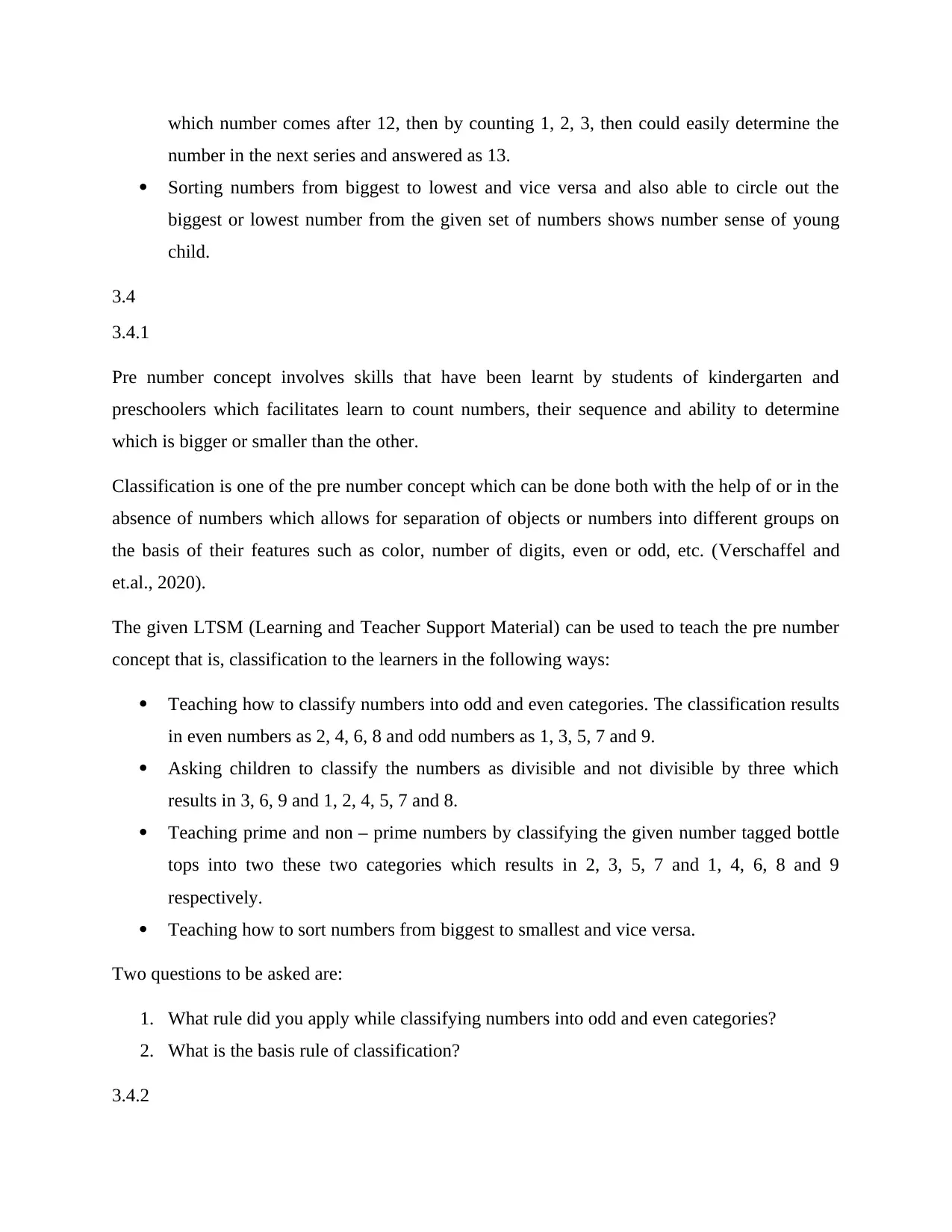
which number comes after 12, then by counting 1, 2, 3, then could easily determine the
number in the next series and answered as 13.
Sorting numbers from biggest to lowest and vice versa and also able to circle out the
biggest or lowest number from the given set of numbers shows number sense of young
child.
3.4
3.4.1
Pre number concept involves skills that have been learnt by students of kindergarten and
preschoolers which facilitates learn to count numbers, their sequence and ability to determine
which is bigger or smaller than the other.
Classification is one of the pre number concept which can be done both with the help of or in the
absence of numbers which allows for separation of objects or numbers into different groups on
the basis of their features such as color, number of digits, even or odd, etc. (Verschaffel and
et.al., 2020).
The given LTSM (Learning and Teacher Support Material) can be used to teach the pre number
concept that is, classification to the learners in the following ways:
Teaching how to classify numbers into odd and even categories. The classification results
in even numbers as 2, 4, 6, 8 and odd numbers as 1, 3, 5, 7 and 9.
Asking children to classify the numbers as divisible and not divisible by three which
results in 3, 6, 9 and 1, 2, 4, 5, 7 and 8.
Teaching prime and non – prime numbers by classifying the given number tagged bottle
tops into two these two categories which results in 2, 3, 5, 7 and 1, 4, 6, 8 and 9
respectively.
Teaching how to sort numbers from biggest to smallest and vice versa.
Two questions to be asked are:
1. What rule did you apply while classifying numbers into odd and even categories?
2. What is the basis rule of classification?
3.4.2
number in the next series and answered as 13.
Sorting numbers from biggest to lowest and vice versa and also able to circle out the
biggest or lowest number from the given set of numbers shows number sense of young
child.
3.4
3.4.1
Pre number concept involves skills that have been learnt by students of kindergarten and
preschoolers which facilitates learn to count numbers, their sequence and ability to determine
which is bigger or smaller than the other.
Classification is one of the pre number concept which can be done both with the help of or in the
absence of numbers which allows for separation of objects or numbers into different groups on
the basis of their features such as color, number of digits, even or odd, etc. (Verschaffel and
et.al., 2020).
The given LTSM (Learning and Teacher Support Material) can be used to teach the pre number
concept that is, classification to the learners in the following ways:
Teaching how to classify numbers into odd and even categories. The classification results
in even numbers as 2, 4, 6, 8 and odd numbers as 1, 3, 5, 7 and 9.
Asking children to classify the numbers as divisible and not divisible by three which
results in 3, 6, 9 and 1, 2, 4, 5, 7 and 8.
Teaching prime and non – prime numbers by classifying the given number tagged bottle
tops into two these two categories which results in 2, 3, 5, 7 and 1, 4, 6, 8 and 9
respectively.
Teaching how to sort numbers from biggest to smallest and vice versa.
Two questions to be asked are:
1. What rule did you apply while classifying numbers into odd and even categories?
2. What is the basis rule of classification?
3.4.2
⊘ This is a preview!⊘
Do you want full access?
Subscribe today to unlock all pages.

Trusted by 1+ million students worldwide
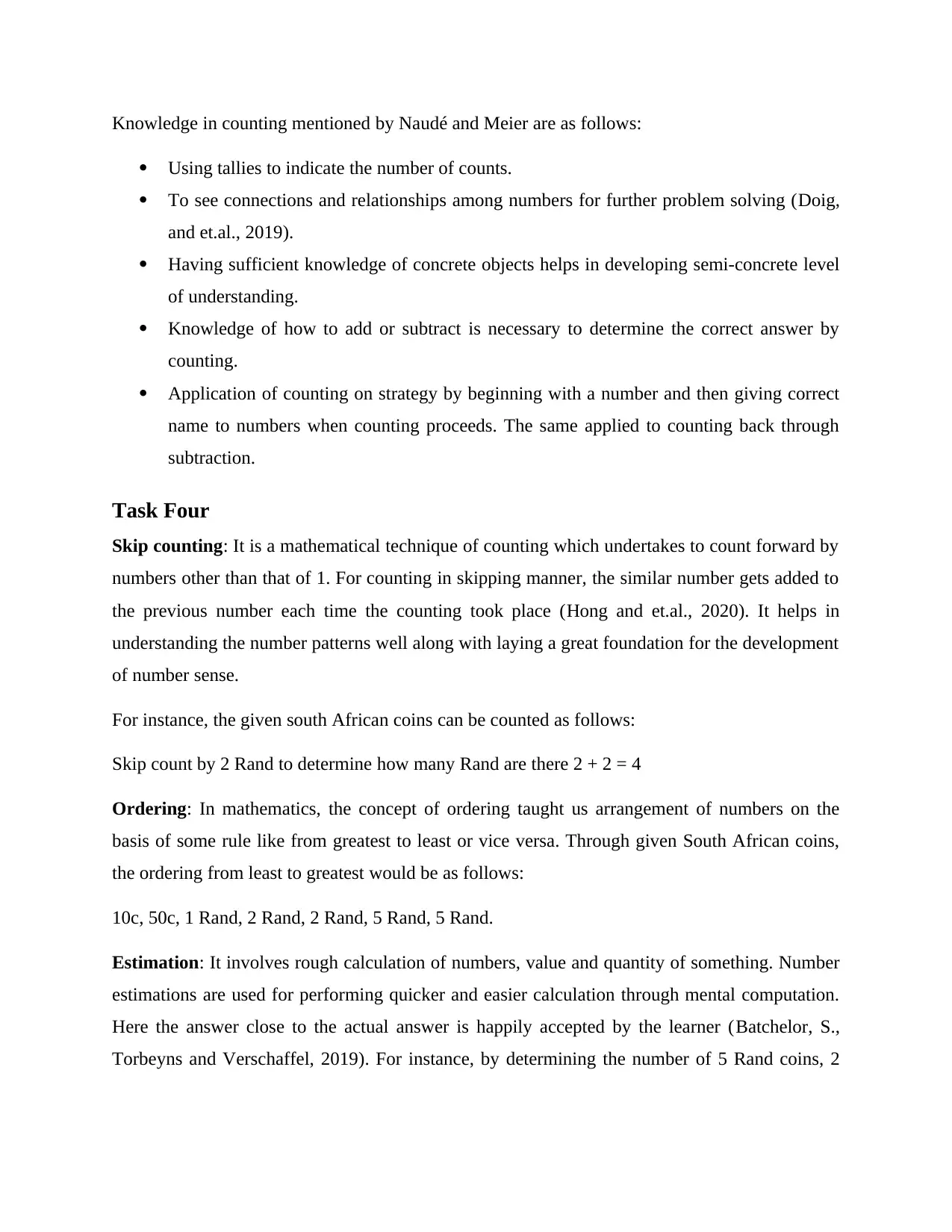
Knowledge in counting mentioned by Naudé and Meier are as follows:
Using tallies to indicate the number of counts.
To see connections and relationships among numbers for further problem solving (Doig,
and et.al., 2019).
Having sufficient knowledge of concrete objects helps in developing semi-concrete level
of understanding.
Knowledge of how to add or subtract is necessary to determine the correct answer by
counting.
Application of counting on strategy by beginning with a number and then giving correct
name to numbers when counting proceeds. The same applied to counting back through
subtraction.
Task Four
Skip counting: It is a mathematical technique of counting which undertakes to count forward by
numbers other than that of 1. For counting in skipping manner, the similar number gets added to
the previous number each time the counting took place (Hong and et.al., 2020). It helps in
understanding the number patterns well along with laying a great foundation for the development
of number sense.
For instance, the given south African coins can be counted as follows:
Skip count by 2 Rand to determine how many Rand are there 2 + 2 = 4
Ordering: In mathematics, the concept of ordering taught us arrangement of numbers on the
basis of some rule like from greatest to least or vice versa. Through given South African coins,
the ordering from least to greatest would be as follows:
10c, 50c, 1 Rand, 2 Rand, 2 Rand, 5 Rand, 5 Rand.
Estimation: It involves rough calculation of numbers, value and quantity of something. Number
estimations are used for performing quicker and easier calculation through mental computation.
Here the answer close to the actual answer is happily accepted by the learner (Batchelor, S.,
Torbeyns and Verschaffel, 2019). For instance, by determining the number of 5 Rand coins, 2
Using tallies to indicate the number of counts.
To see connections and relationships among numbers for further problem solving (Doig,
and et.al., 2019).
Having sufficient knowledge of concrete objects helps in developing semi-concrete level
of understanding.
Knowledge of how to add or subtract is necessary to determine the correct answer by
counting.
Application of counting on strategy by beginning with a number and then giving correct
name to numbers when counting proceeds. The same applied to counting back through
subtraction.
Task Four
Skip counting: It is a mathematical technique of counting which undertakes to count forward by
numbers other than that of 1. For counting in skipping manner, the similar number gets added to
the previous number each time the counting took place (Hong and et.al., 2020). It helps in
understanding the number patterns well along with laying a great foundation for the development
of number sense.
For instance, the given south African coins can be counted as follows:
Skip count by 2 Rand to determine how many Rand are there 2 + 2 = 4
Ordering: In mathematics, the concept of ordering taught us arrangement of numbers on the
basis of some rule like from greatest to least or vice versa. Through given South African coins,
the ordering from least to greatest would be as follows:
10c, 50c, 1 Rand, 2 Rand, 2 Rand, 5 Rand, 5 Rand.
Estimation: It involves rough calculation of numbers, value and quantity of something. Number
estimations are used for performing quicker and easier calculation through mental computation.
Here the answer close to the actual answer is happily accepted by the learner (Batchelor, S.,
Torbeyns and Verschaffel, 2019). For instance, by determining the number of 5 Rand coins, 2
Paraphrase This Document
Need a fresh take? Get an instant paraphrase of this document with our AI Paraphraser
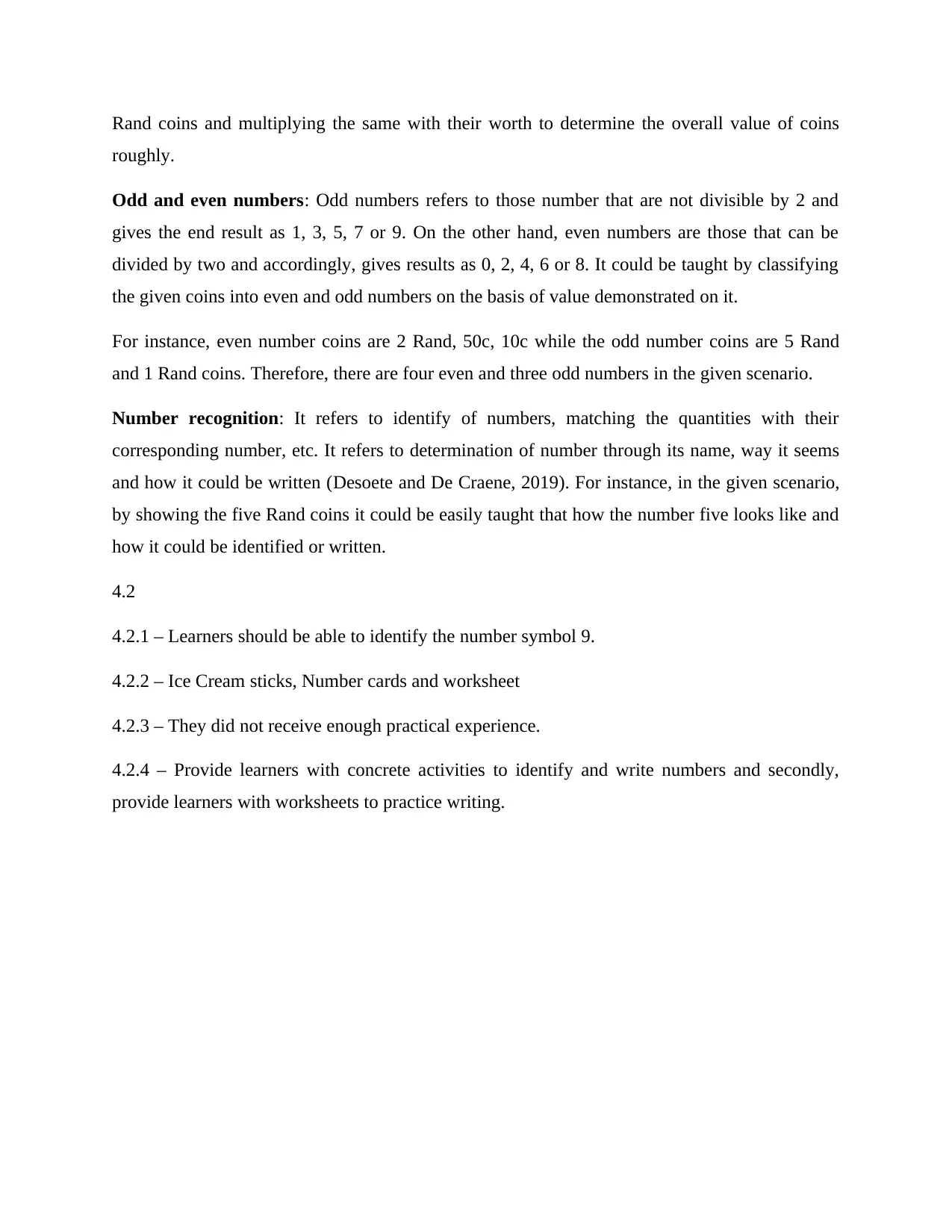
Rand coins and multiplying the same with their worth to determine the overall value of coins
roughly.
Odd and even numbers: Odd numbers refers to those number that are not divisible by 2 and
gives the end result as 1, 3, 5, 7 or 9. On the other hand, even numbers are those that can be
divided by two and accordingly, gives results as 0, 2, 4, 6 or 8. It could be taught by classifying
the given coins into even and odd numbers on the basis of value demonstrated on it.
For instance, even number coins are 2 Rand, 50c, 10c while the odd number coins are 5 Rand
and 1 Rand coins. Therefore, there are four even and three odd numbers in the given scenario.
Number recognition: It refers to identify of numbers, matching the quantities with their
corresponding number, etc. It refers to determination of number through its name, way it seems
and how it could be written (Desoete and De Craene, 2019). For instance, in the given scenario,
by showing the five Rand coins it could be easily taught that how the number five looks like and
how it could be identified or written.
4.2
4.2.1 – Learners should be able to identify the number symbol 9.
4.2.2 – Ice Cream sticks, Number cards and worksheet
4.2.3 – They did not receive enough practical experience.
4.2.4 – Provide learners with concrete activities to identify and write numbers and secondly,
provide learners with worksheets to practice writing.
roughly.
Odd and even numbers: Odd numbers refers to those number that are not divisible by 2 and
gives the end result as 1, 3, 5, 7 or 9. On the other hand, even numbers are those that can be
divided by two and accordingly, gives results as 0, 2, 4, 6 or 8. It could be taught by classifying
the given coins into even and odd numbers on the basis of value demonstrated on it.
For instance, even number coins are 2 Rand, 50c, 10c while the odd number coins are 5 Rand
and 1 Rand coins. Therefore, there are four even and three odd numbers in the given scenario.
Number recognition: It refers to identify of numbers, matching the quantities with their
corresponding number, etc. It refers to determination of number through its name, way it seems
and how it could be written (Desoete and De Craene, 2019). For instance, in the given scenario,
by showing the five Rand coins it could be easily taught that how the number five looks like and
how it could be identified or written.
4.2
4.2.1 – Learners should be able to identify the number symbol 9.
4.2.2 – Ice Cream sticks, Number cards and worksheet
4.2.3 – They did not receive enough practical experience.
4.2.4 – Provide learners with concrete activities to identify and write numbers and secondly,
provide learners with worksheets to practice writing.
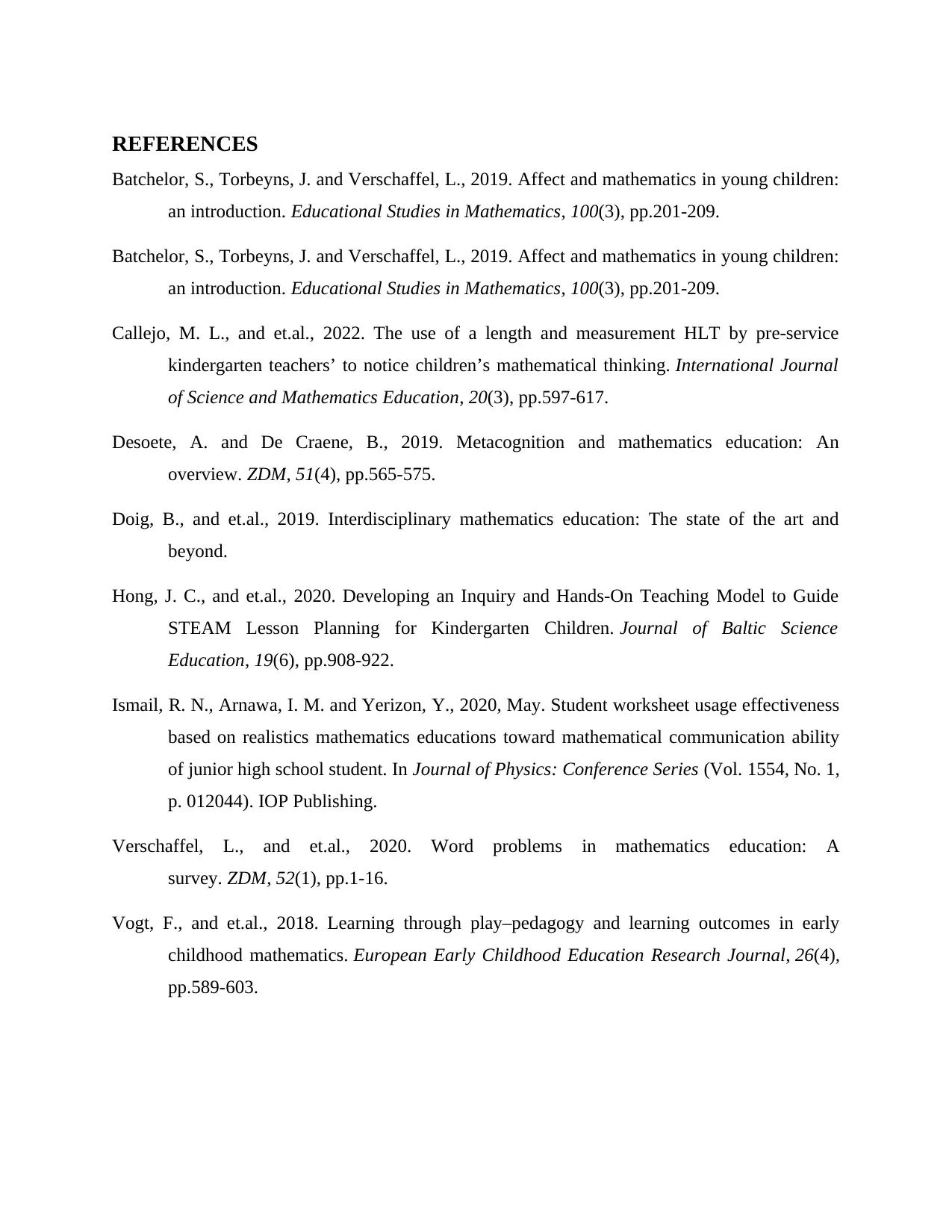
REFERENCES
Batchelor, S., Torbeyns, J. and Verschaffel, L., 2019. Affect and mathematics in young children:
an introduction. Educational Studies in Mathematics, 100(3), pp.201-209.
Batchelor, S., Torbeyns, J. and Verschaffel, L., 2019. Affect and mathematics in young children:
an introduction. Educational Studies in Mathematics, 100(3), pp.201-209.
Callejo, M. L., and et.al., 2022. The use of a length and measurement HLT by pre-service
kindergarten teachers’ to notice children’s mathematical thinking. International Journal
of Science and Mathematics Education, 20(3), pp.597-617.
Desoete, A. and De Craene, B., 2019. Metacognition and mathematics education: An
overview. ZDM, 51(4), pp.565-575.
Doig, B., and et.al., 2019. Interdisciplinary mathematics education: The state of the art and
beyond.
Hong, J. C., and et.al., 2020. Developing an Inquiry and Hands-On Teaching Model to Guide
STEAM Lesson Planning for Kindergarten Children. Journal of Baltic Science
Education, 19(6), pp.908-922.
Ismail, R. N., Arnawa, I. M. and Yerizon, Y., 2020, May. Student worksheet usage effectiveness
based on realistics mathematics educations toward mathematical communication ability
of junior high school student. In Journal of Physics: Conference Series (Vol. 1554, No. 1,
p. 012044). IOP Publishing.
Verschaffel, L., and et.al., 2020. Word problems in mathematics education: A
survey. ZDM, 52(1), pp.1-16.
Vogt, F., and et.al., 2018. Learning through play–pedagogy and learning outcomes in early
childhood mathematics. European Early Childhood Education Research Journal, 26(4),
pp.589-603.
Batchelor, S., Torbeyns, J. and Verschaffel, L., 2019. Affect and mathematics in young children:
an introduction. Educational Studies in Mathematics, 100(3), pp.201-209.
Batchelor, S., Torbeyns, J. and Verschaffel, L., 2019. Affect and mathematics in young children:
an introduction. Educational Studies in Mathematics, 100(3), pp.201-209.
Callejo, M. L., and et.al., 2022. The use of a length and measurement HLT by pre-service
kindergarten teachers’ to notice children’s mathematical thinking. International Journal
of Science and Mathematics Education, 20(3), pp.597-617.
Desoete, A. and De Craene, B., 2019. Metacognition and mathematics education: An
overview. ZDM, 51(4), pp.565-575.
Doig, B., and et.al., 2019. Interdisciplinary mathematics education: The state of the art and
beyond.
Hong, J. C., and et.al., 2020. Developing an Inquiry and Hands-On Teaching Model to Guide
STEAM Lesson Planning for Kindergarten Children. Journal of Baltic Science
Education, 19(6), pp.908-922.
Ismail, R. N., Arnawa, I. M. and Yerizon, Y., 2020, May. Student worksheet usage effectiveness
based on realistics mathematics educations toward mathematical communication ability
of junior high school student. In Journal of Physics: Conference Series (Vol. 1554, No. 1,
p. 012044). IOP Publishing.
Verschaffel, L., and et.al., 2020. Word problems in mathematics education: A
survey. ZDM, 52(1), pp.1-16.
Vogt, F., and et.al., 2018. Learning through play–pedagogy and learning outcomes in early
childhood mathematics. European Early Childhood Education Research Journal, 26(4),
pp.589-603.
⊘ This is a preview!⊘
Do you want full access?
Subscribe today to unlock all pages.

Trusted by 1+ million students worldwide

1 out of 10
Your All-in-One AI-Powered Toolkit for Academic Success.
+13062052269
info@desklib.com
Available 24*7 on WhatsApp / Email
![[object Object]](/_next/static/media/star-bottom.7253800d.svg)
Unlock your academic potential
Copyright © 2020–2025 A2Z Services. All Rights Reserved. Developed and managed by ZUCOL.